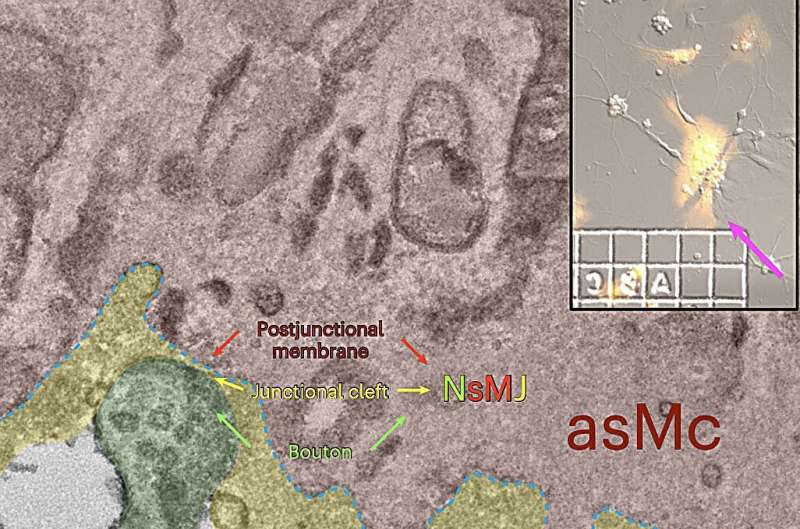January 16, 2024 feature
This article has been reviewed according to Science X's editorial process and policies. Editors have highlighted the following attributes while ensuring the content's credibility:
fact-checked
peer-reviewed publication
trusted source
proofread
Study unveils synaptic-like transmission mechanism driving neurovascular coupling

The activity of neurons in the mammalian brain has been found to be linked with various physiological processes, including the flow of blood that provides them with the energy required to function (i.e., cerebral blood flow). This close relationship between brain cells and blood vessels is known as neurovascular coupling (NVC).
Disruptions or alterations of this relationship have often been observed in patients diagnosed with various neuro-pathologies and neurodegenerative diseases. For instance, a reduced NVC has been linked with both Alzheimer's disease and strokes, both of which can be highly impairing and even life-threatening.
Researchers at Westlake University, the Westlake Institute for Advanced Study and other institutes in China recently carried out a study aimed at better understanding the biological and neural processes underpinning NVC. Their paper, published in Nature Neuroscience, unveiled a synaptic-like transmission mechanism that appears to drive NVC, which occurs between neural-arteriolar smooth muscle cell junctions (NsMJs), which are junctions connecting neurons and the smooth muscle of arterioles.
"Although cell-type specificity has been implicated in NVC, how active neural information is conveyed to the targeted arterioles in the brain remains poorly understood," Dongdong Zhang, Jiayu Ruan and their colleagues write in their paper. "Using two-photon focal optogenetics in the mouse cerebral cortex, we demonstrate that single glutamatergic axons dilate their innervating arterioles via synaptic-like transmission between neural–arteriolar smooth muscle cell junctions."
To further examine processes underpinning NVC, Zhang, Ruan and their colleagues analyzed data collected using a combination of cutting-edge technologies and optogenetic techniques, including correlative light electron microscopy (CLEM), RNA-sequencing, immunogold EM, calcium imaging and single-axon optogenetics. These tools collectively allowed them to closely study how neurons contribute to cerebral blood flow.
The researchers first identified different types of NsMJ structures and neurotransmitter receptors expressed by smooth muscle cells of arterioles. They also demonstrated that functional NMDA receptors, which modulate the excitatory neurotransmitter glutamate involved in synaptic plasticity and various key cognitive functions, can be found in the smooth muscle cells of mouse, primate, and human arterioles.
"The presynaptic parental-daughter bouton makes dual innervations on postsynaptic dendrites and on arteriolar smooth muscle cells (aSMCs), which express many types of neuromediator receptors, including a low level of glutamate NMDA receptor subunit 1 (Grin1)," the researchers explain in their paper.
"Disruption of NsMJ transmission by aSMC-specific knockout of GluN1 diminished optogenetic and whisker stimulation-caused functional hyperemia. Notably, the absence of GluN1 subunit in aSMCs reduced brain atrophy following cerebral ischemia by preventing Ca2+ overload in aSMCs during arteriolar constriction caused by the ischemia-induced spreading depolarization."
Essentially, Zhang, Ruan and their colleagues found that the genetic manipulation of these NMDA receptors in the ASMCs of mice resulted in a diminished narrowing of blood vessels (i.e., vasoconstriction) and facilitated their recovery after they suffered an ischemic stroke. Overall, their results suggest that the transmission mechanism they uncovered plays a crucial role in NVC.
"Our findings reveal that NsMJ transmission drives NVC and open up a new avenue for studying stroke," Zhang, Ruan and their colleagues write.
This study could soon pave the way for new research exploring the potential role of the transmission between neural axons and ASMCs uncovered and ischemic strokes. In addition, it could inform the development of new treatments to prevent the spreading of damage caused by ischemic strokes and facilitate the recovery of affected patients.
More information: Dongdong Zhang et al, Synaptic-like transmission between neural axons and arteriolar smooth muscle cells drives cerebral neurovascular coupling, Nature Neuroscience (2024). DOI: 10.1038/s41593-023-01515-0.
© 2024 Science X Network



















